Comprehensive Analysis: The Role of Management in Resource Utilization
VerifiedAdded on 2022/01/19
|14
|3003
|75
Report
AI Summary
This report delves into the critical role of management in resource utilization within organizations, drawing upon various theories and literature. It emphasizes the importance of efficient resource management for achieving competitive advantages, as supported by the resource-based view (RBV). The report explores key concepts such as knowledge management, stakeholder relationships, and the VRIN framework (Valuable, Rare, Inimitable, Non-substitutable) as tools for evaluating organizational development and sustainability. Furthermore, it examines the impact of leadership capabilities, talent retention, lead-time management, and strategic resource planning on overall organizational performance. The analysis highlights how effective management can leverage these factors to optimize resource allocation, enhance customer satisfaction, and foster a competitive edge. The report underscores the significance of management's skills and expertise in interpreting organizational vision and strategy to achieve the efficient use of valuable resources. Finally, the report stresses the importance of knowledge and stakeholder relationship management in the overall success of the organization.
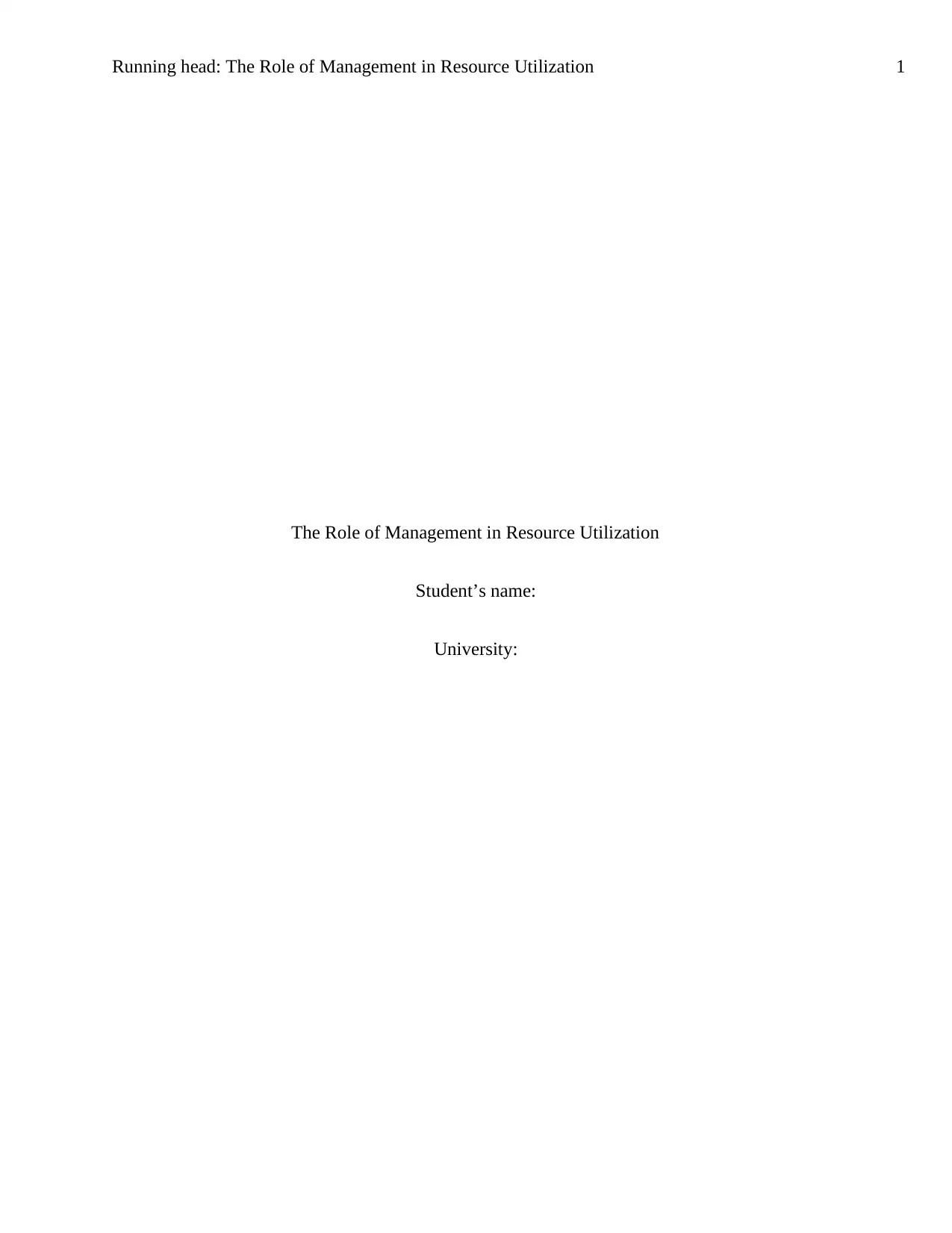
Running head: The Role of Management in Resource Utilization 1
The Role of Management in Resource Utilization
Student’s name:
University:
The Role of Management in Resource Utilization
Student’s name:
University:
Paraphrase This Document
Need a fresh take? Get an instant paraphrase of this document with our AI Paraphraser
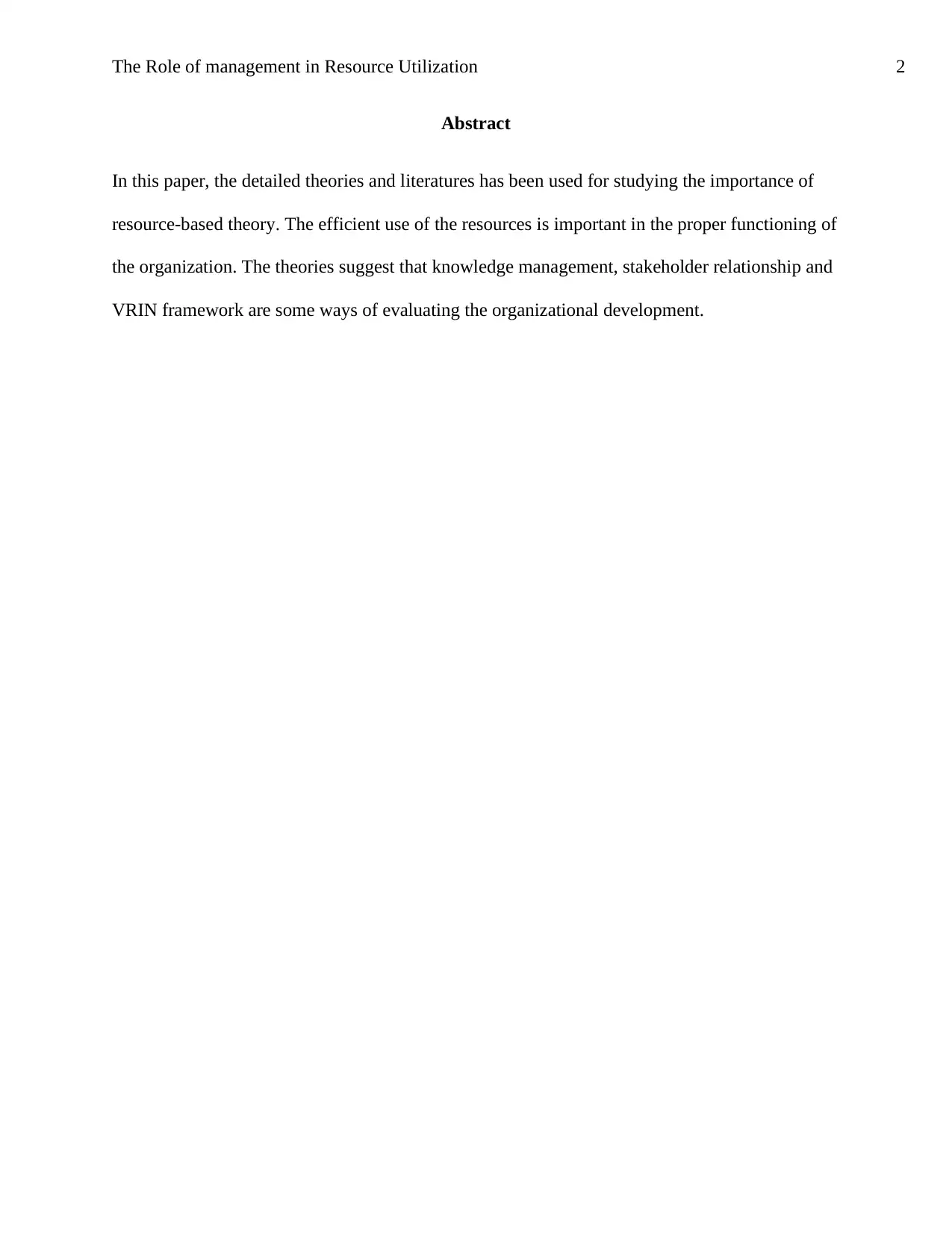
The Role of management in Resource Utilization 2
Abstract
In this paper, the detailed theories and literatures has been used for studying the importance of
resource-based theory. The efficient use of the resources is important in the proper functioning of
the organization. The theories suggest that knowledge management, stakeholder relationship and
VRIN framework are some ways of evaluating the organizational development.
Abstract
In this paper, the detailed theories and literatures has been used for studying the importance of
resource-based theory. The efficient use of the resources is important in the proper functioning of
the organization. The theories suggest that knowledge management, stakeholder relationship and
VRIN framework are some ways of evaluating the organizational development.
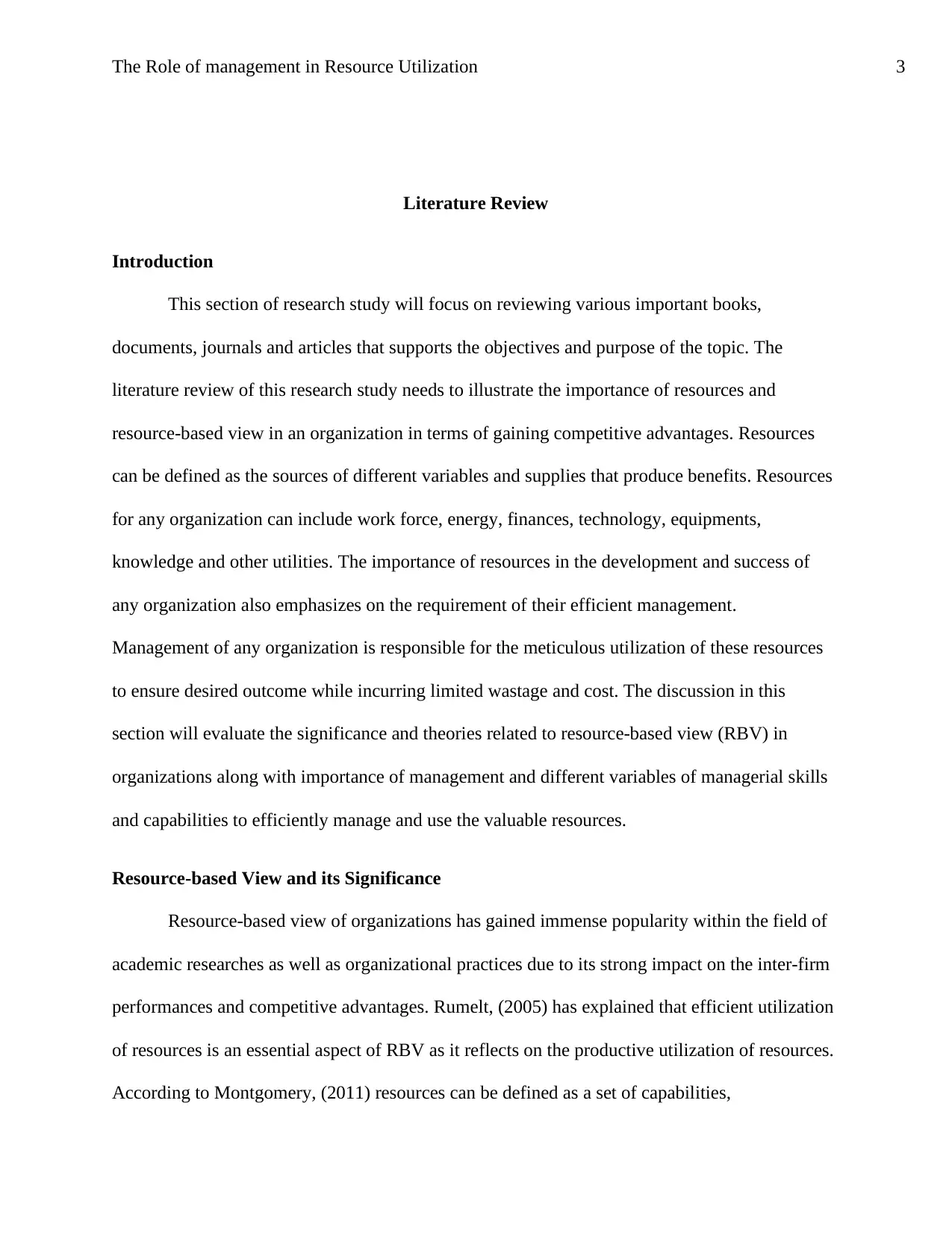
The Role of management in Resource Utilization 3
Literature Review
Introduction
This section of research study will focus on reviewing various important books,
documents, journals and articles that supports the objectives and purpose of the topic. The
literature review of this research study needs to illustrate the importance of resources and
resource-based view in an organization in terms of gaining competitive advantages. Resources
can be defined as the sources of different variables and supplies that produce benefits. Resources
for any organization can include work force, energy, finances, technology, equipments,
knowledge and other utilities. The importance of resources in the development and success of
any organization also emphasizes on the requirement of their efficient management.
Management of any organization is responsible for the meticulous utilization of these resources
to ensure desired outcome while incurring limited wastage and cost. The discussion in this
section will evaluate the significance and theories related to resource-based view (RBV) in
organizations along with importance of management and different variables of managerial skills
and capabilities to efficiently manage and use the valuable resources.
Resource-based View and its Significance
Resource-based view of organizations has gained immense popularity within the field of
academic researches as well as organizational practices due to its strong impact on the inter-firm
performances and competitive advantages. Rumelt, (2005) has explained that efficient utilization
of resources is an essential aspect of RBV as it reflects on the productive utilization of resources.
According to Montgomery, (2011) resources can be defined as a set of capabilities,
Literature Review
Introduction
This section of research study will focus on reviewing various important books,
documents, journals and articles that supports the objectives and purpose of the topic. The
literature review of this research study needs to illustrate the importance of resources and
resource-based view in an organization in terms of gaining competitive advantages. Resources
can be defined as the sources of different variables and supplies that produce benefits. Resources
for any organization can include work force, energy, finances, technology, equipments,
knowledge and other utilities. The importance of resources in the development and success of
any organization also emphasizes on the requirement of their efficient management.
Management of any organization is responsible for the meticulous utilization of these resources
to ensure desired outcome while incurring limited wastage and cost. The discussion in this
section will evaluate the significance and theories related to resource-based view (RBV) in
organizations along with importance of management and different variables of managerial skills
and capabilities to efficiently manage and use the valuable resources.
Resource-based View and its Significance
Resource-based view of organizations has gained immense popularity within the field of
academic researches as well as organizational practices due to its strong impact on the inter-firm
performances and competitive advantages. Rumelt, (2005) has explained that efficient utilization
of resources is an essential aspect of RBV as it reflects on the productive utilization of resources.
According to Montgomery, (2011) resources can be defined as a set of capabilities,
⊘ This is a preview!⊘
Do you want full access?
Subscribe today to unlock all pages.

Trusted by 1+ million students worldwide
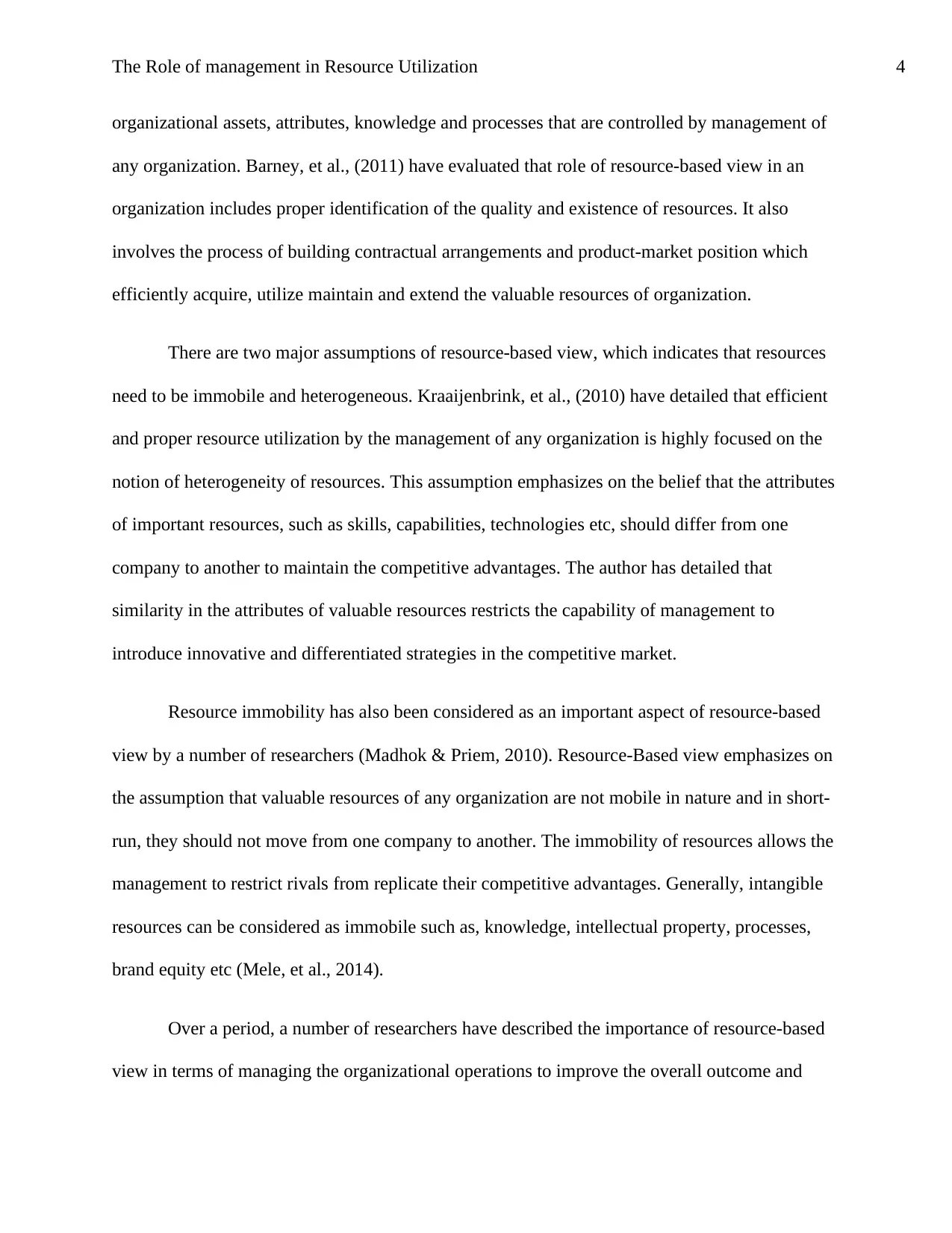
The Role of management in Resource Utilization 4
organizational assets, attributes, knowledge and processes that are controlled by management of
any organization. Barney, et al., (2011) have evaluated that role of resource-based view in an
organization includes proper identification of the quality and existence of resources. It also
involves the process of building contractual arrangements and product-market position which
efficiently acquire, utilize maintain and extend the valuable resources of organization.
There are two major assumptions of resource-based view, which indicates that resources
need to be immobile and heterogeneous. Kraaijenbrink, et al., (2010) have detailed that efficient
and proper resource utilization by the management of any organization is highly focused on the
notion of heterogeneity of resources. This assumption emphasizes on the belief that the attributes
of important resources, such as skills, capabilities, technologies etc, should differ from one
company to another to maintain the competitive advantages. The author has detailed that
similarity in the attributes of valuable resources restricts the capability of management to
introduce innovative and differentiated strategies in the competitive market.
Resource immobility has also been considered as an important aspect of resource-based
view by a number of researchers (Madhok & Priem, 2010). Resource-Based view emphasizes on
the assumption that valuable resources of any organization are not mobile in nature and in short-
run, they should not move from one company to another. The immobility of resources allows the
management to restrict rivals from replicate their competitive advantages. Generally, intangible
resources can be considered as immobile such as, knowledge, intellectual property, processes,
brand equity etc (Mele, et al., 2014).
Over a period, a number of researchers have described the importance of resource-based
view in terms of managing the organizational operations to improve the overall outcome and
organizational assets, attributes, knowledge and processes that are controlled by management of
any organization. Barney, et al., (2011) have evaluated that role of resource-based view in an
organization includes proper identification of the quality and existence of resources. It also
involves the process of building contractual arrangements and product-market position which
efficiently acquire, utilize maintain and extend the valuable resources of organization.
There are two major assumptions of resource-based view, which indicates that resources
need to be immobile and heterogeneous. Kraaijenbrink, et al., (2010) have detailed that efficient
and proper resource utilization by the management of any organization is highly focused on the
notion of heterogeneity of resources. This assumption emphasizes on the belief that the attributes
of important resources, such as skills, capabilities, technologies etc, should differ from one
company to another to maintain the competitive advantages. The author has detailed that
similarity in the attributes of valuable resources restricts the capability of management to
introduce innovative and differentiated strategies in the competitive market.
Resource immobility has also been considered as an important aspect of resource-based
view by a number of researchers (Madhok & Priem, 2010). Resource-Based view emphasizes on
the assumption that valuable resources of any organization are not mobile in nature and in short-
run, they should not move from one company to another. The immobility of resources allows the
management to restrict rivals from replicate their competitive advantages. Generally, intangible
resources can be considered as immobile such as, knowledge, intellectual property, processes,
brand equity etc (Mele, et al., 2014).
Over a period, a number of researchers have described the importance of resource-based
view in terms of managing the organizational operations to improve the overall outcome and
Paraphrase This Document
Need a fresh take? Get an instant paraphrase of this document with our AI Paraphraser
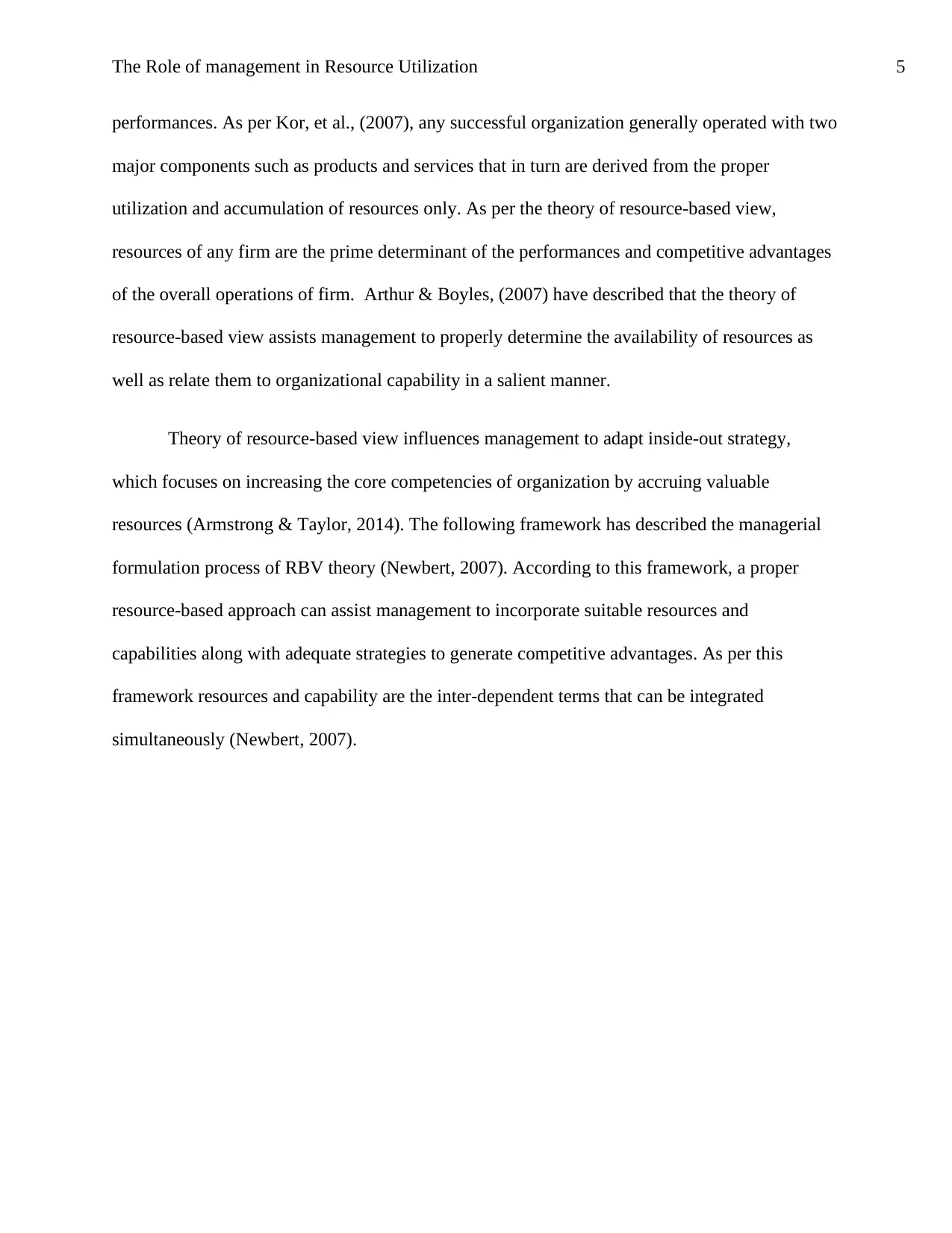
The Role of management in Resource Utilization 5
performances. As per Kor, et al., (2007), any successful organization generally operated with two
major components such as products and services that in turn are derived from the proper
utilization and accumulation of resources only. As per the theory of resource-based view,
resources of any firm are the prime determinant of the performances and competitive advantages
of the overall operations of firm. Arthur & Boyles, (2007) have described that the theory of
resource-based view assists management to properly determine the availability of resources as
well as relate them to organizational capability in a salient manner.
Theory of resource-based view influences management to adapt inside-out strategy,
which focuses on increasing the core competencies of organization by accruing valuable
resources (Armstrong & Taylor, 2014). The following framework has described the managerial
formulation process of RBV theory (Newbert, 2007). According to this framework, a proper
resource-based approach can assist management to incorporate suitable resources and
capabilities along with adequate strategies to generate competitive advantages. As per this
framework resources and capability are the inter-dependent terms that can be integrated
simultaneously (Newbert, 2007).
performances. As per Kor, et al., (2007), any successful organization generally operated with two
major components such as products and services that in turn are derived from the proper
utilization and accumulation of resources only. As per the theory of resource-based view,
resources of any firm are the prime determinant of the performances and competitive advantages
of the overall operations of firm. Arthur & Boyles, (2007) have described that the theory of
resource-based view assists management to properly determine the availability of resources as
well as relate them to organizational capability in a salient manner.
Theory of resource-based view influences management to adapt inside-out strategy,
which focuses on increasing the core competencies of organization by accruing valuable
resources (Armstrong & Taylor, 2014). The following framework has described the managerial
formulation process of RBV theory (Newbert, 2007). According to this framework, a proper
resource-based approach can assist management to incorporate suitable resources and
capabilities along with adequate strategies to generate competitive advantages. As per this
framework resources and capability are the inter-dependent terms that can be integrated
simultaneously (Newbert, 2007).
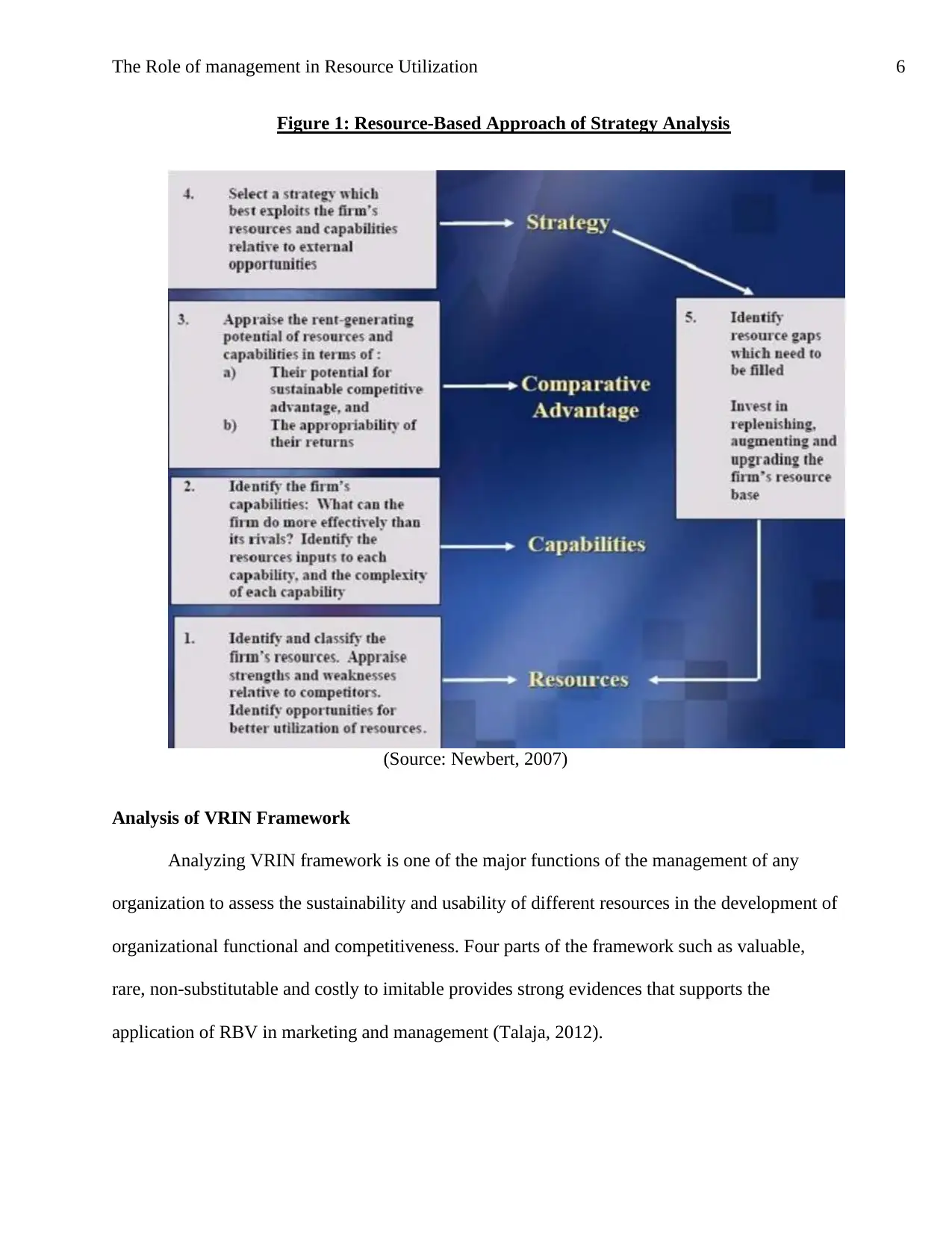
The Role of management in Resource Utilization 6
Figure 1: Resource-Based Approach of Strategy Analysis
(Source: Newbert, 2007)
Analysis of VRIN Framework
Analyzing VRIN framework is one of the major functions of the management of any
organization to assess the sustainability and usability of different resources in the development of
organizational functional and competitiveness. Four parts of the framework such as valuable,
rare, non-substitutable and costly to imitable provides strong evidences that supports the
application of RBV in marketing and management (Talaja, 2012).
Figure 1: Resource-Based Approach of Strategy Analysis
(Source: Newbert, 2007)
Analysis of VRIN Framework
Analyzing VRIN framework is one of the major functions of the management of any
organization to assess the sustainability and usability of different resources in the development of
organizational functional and competitiveness. Four parts of the framework such as valuable,
rare, non-substitutable and costly to imitable provides strong evidences that supports the
application of RBV in marketing and management (Talaja, 2012).
⊘ This is a preview!⊘
Do you want full access?
Subscribe today to unlock all pages.

Trusted by 1+ million students worldwide
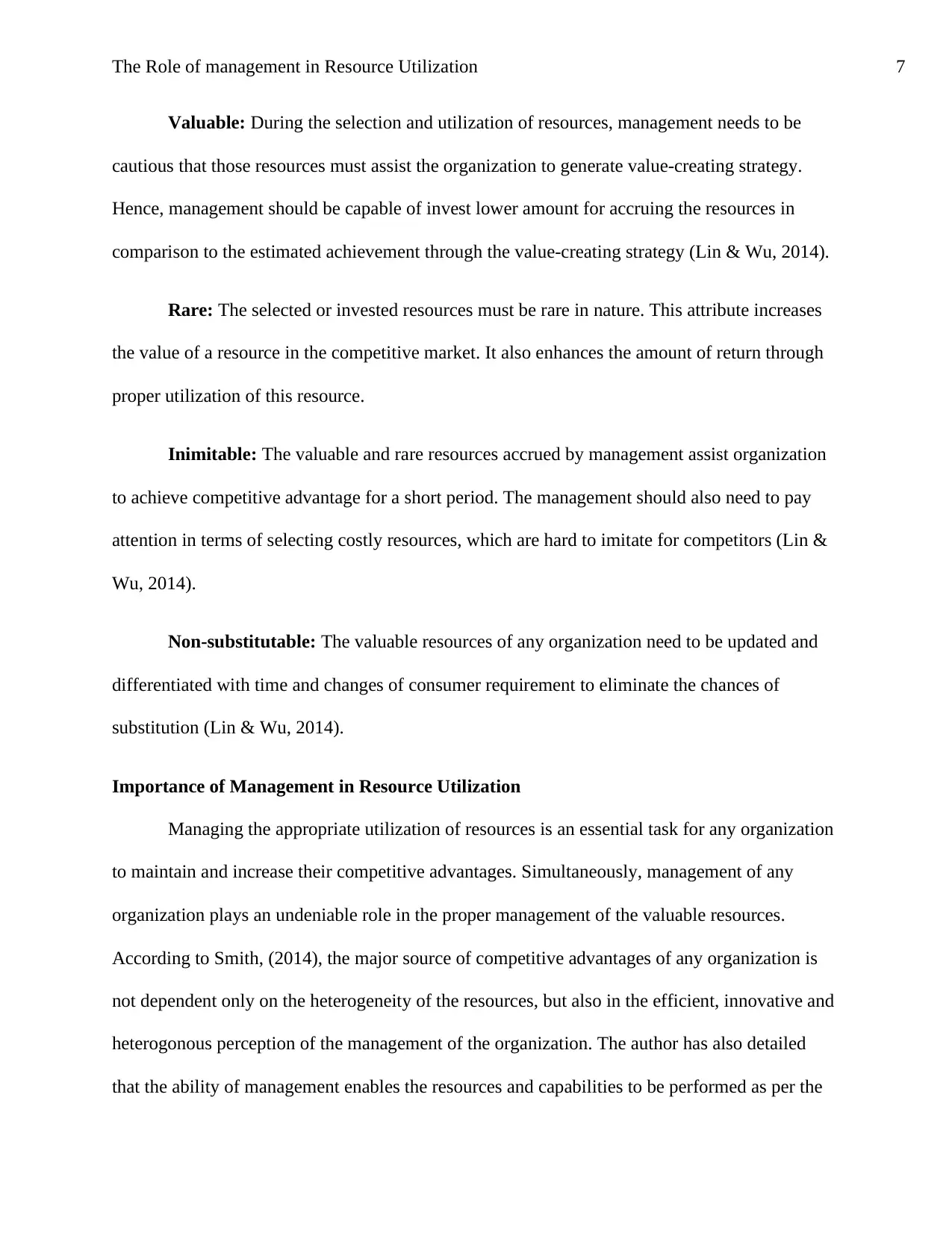
The Role of management in Resource Utilization 7
Valuable: During the selection and utilization of resources, management needs to be
cautious that those resources must assist the organization to generate value-creating strategy.
Hence, management should be capable of invest lower amount for accruing the resources in
comparison to the estimated achievement through the value-creating strategy (Lin & Wu, 2014).
Rare: The selected or invested resources must be rare in nature. This attribute increases
the value of a resource in the competitive market. It also enhances the amount of return through
proper utilization of this resource.
Inimitable: The valuable and rare resources accrued by management assist organization
to achieve competitive advantage for a short period. The management should also need to pay
attention in terms of selecting costly resources, which are hard to imitate for competitors (Lin &
Wu, 2014).
Non-substitutable: The valuable resources of any organization need to be updated and
differentiated with time and changes of consumer requirement to eliminate the chances of
substitution (Lin & Wu, 2014).
Importance of Management in Resource Utilization
Managing the appropriate utilization of resources is an essential task for any organization
to maintain and increase their competitive advantages. Simultaneously, management of any
organization plays an undeniable role in the proper management of the valuable resources.
According to Smith, (2014), the major source of competitive advantages of any organization is
not dependent only on the heterogeneity of the resources, but also in the efficient, innovative and
heterogonous perception of the management of the organization. The author has also detailed
that the ability of management enables the resources and capabilities to be performed as per the
Valuable: During the selection and utilization of resources, management needs to be
cautious that those resources must assist the organization to generate value-creating strategy.
Hence, management should be capable of invest lower amount for accruing the resources in
comparison to the estimated achievement through the value-creating strategy (Lin & Wu, 2014).
Rare: The selected or invested resources must be rare in nature. This attribute increases
the value of a resource in the competitive market. It also enhances the amount of return through
proper utilization of this resource.
Inimitable: The valuable and rare resources accrued by management assist organization
to achieve competitive advantage for a short period. The management should also need to pay
attention in terms of selecting costly resources, which are hard to imitate for competitors (Lin &
Wu, 2014).
Non-substitutable: The valuable resources of any organization need to be updated and
differentiated with time and changes of consumer requirement to eliminate the chances of
substitution (Lin & Wu, 2014).
Importance of Management in Resource Utilization
Managing the appropriate utilization of resources is an essential task for any organization
to maintain and increase their competitive advantages. Simultaneously, management of any
organization plays an undeniable role in the proper management of the valuable resources.
According to Smith, (2014), the major source of competitive advantages of any organization is
not dependent only on the heterogeneity of the resources, but also in the efficient, innovative and
heterogonous perception of the management of the organization. The author has also detailed
that the ability of management enables the resources and capabilities to be performed as per the
Paraphrase This Document
Need a fresh take? Get an instant paraphrase of this document with our AI Paraphraser
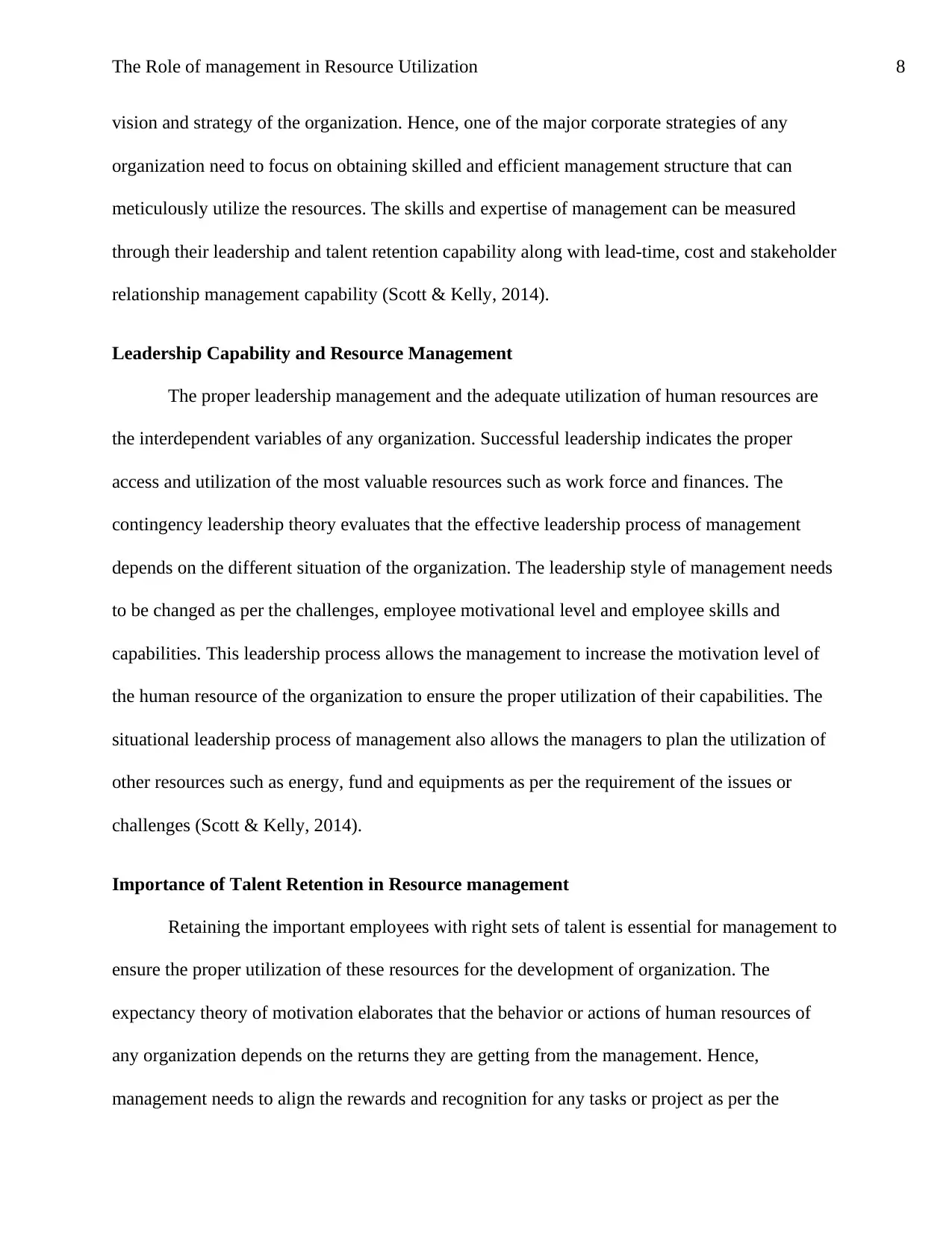
The Role of management in Resource Utilization 8
vision and strategy of the organization. Hence, one of the major corporate strategies of any
organization need to focus on obtaining skilled and efficient management structure that can
meticulously utilize the resources. The skills and expertise of management can be measured
through their leadership and talent retention capability along with lead-time, cost and stakeholder
relationship management capability (Scott & Kelly, 2014).
Leadership Capability and Resource Management
The proper leadership management and the adequate utilization of human resources are
the interdependent variables of any organization. Successful leadership indicates the proper
access and utilization of the most valuable resources such as work force and finances. The
contingency leadership theory evaluates that the effective leadership process of management
depends on the different situation of the organization. The leadership style of management needs
to be changed as per the challenges, employee motivational level and employee skills and
capabilities. This leadership process allows the management to increase the motivation level of
the human resource of the organization to ensure the proper utilization of their capabilities. The
situational leadership process of management also allows the managers to plan the utilization of
other resources such as energy, fund and equipments as per the requirement of the issues or
challenges (Scott & Kelly, 2014).
Importance of Talent Retention in Resource management
Retaining the important employees with right sets of talent is essential for management to
ensure the proper utilization of these resources for the development of organization. The
expectancy theory of motivation elaborates that the behavior or actions of human resources of
any organization depends on the returns they are getting from the management. Hence,
management needs to align the rewards and recognition for any tasks or project as per the
vision and strategy of the organization. Hence, one of the major corporate strategies of any
organization need to focus on obtaining skilled and efficient management structure that can
meticulously utilize the resources. The skills and expertise of management can be measured
through their leadership and talent retention capability along with lead-time, cost and stakeholder
relationship management capability (Scott & Kelly, 2014).
Leadership Capability and Resource Management
The proper leadership management and the adequate utilization of human resources are
the interdependent variables of any organization. Successful leadership indicates the proper
access and utilization of the most valuable resources such as work force and finances. The
contingency leadership theory evaluates that the effective leadership process of management
depends on the different situation of the organization. The leadership style of management needs
to be changed as per the challenges, employee motivational level and employee skills and
capabilities. This leadership process allows the management to increase the motivation level of
the human resource of the organization to ensure the proper utilization of their capabilities. The
situational leadership process of management also allows the managers to plan the utilization of
other resources such as energy, fund and equipments as per the requirement of the issues or
challenges (Scott & Kelly, 2014).
Importance of Talent Retention in Resource management
Retaining the important employees with right sets of talent is essential for management to
ensure the proper utilization of these resources for the development of organization. The
expectancy theory of motivation elaborates that the behavior or actions of human resources of
any organization depends on the returns they are getting from the management. Hence,
management needs to align the rewards and recognition for any tasks or project as per the
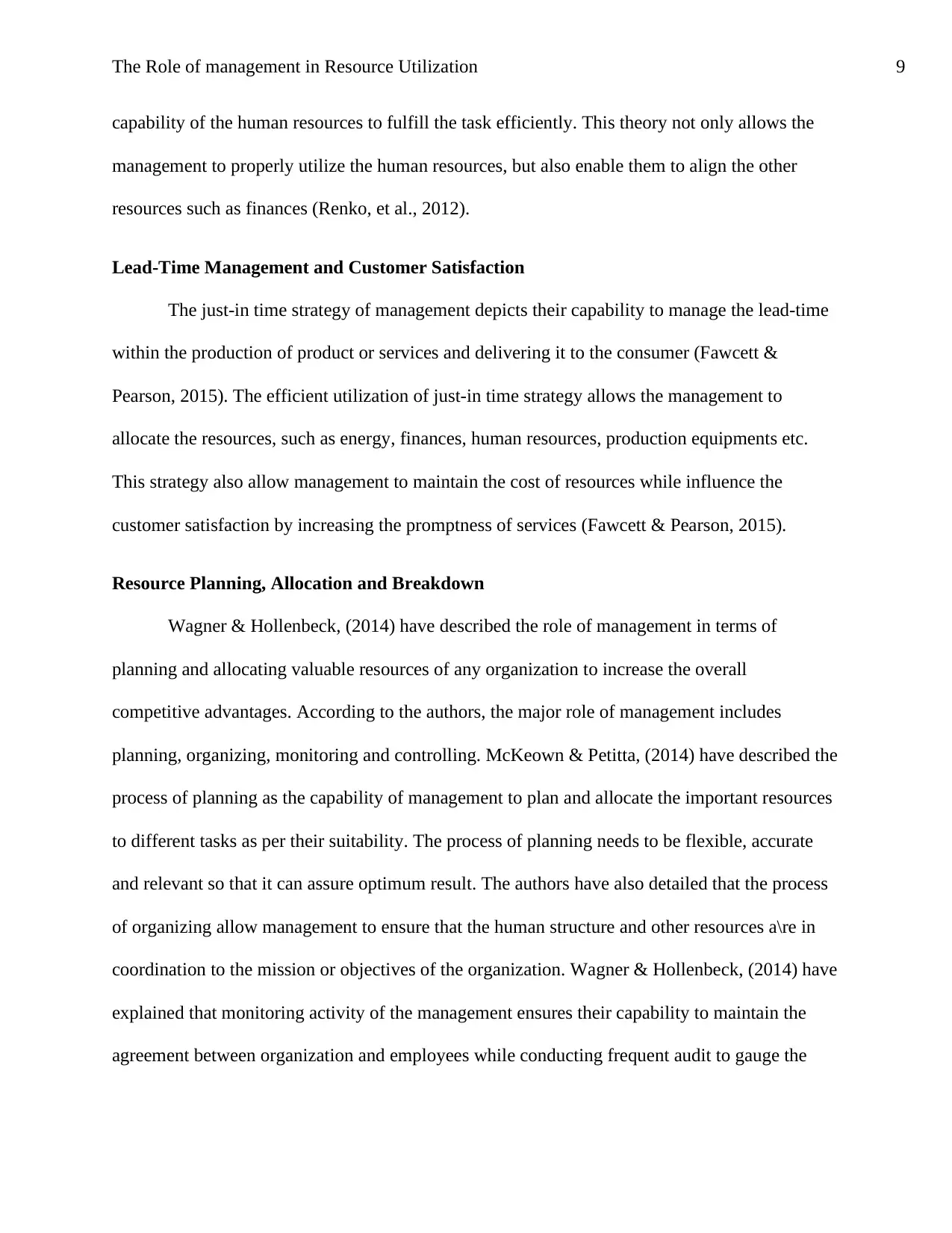
The Role of management in Resource Utilization 9
capability of the human resources to fulfill the task efficiently. This theory not only allows the
management to properly utilize the human resources, but also enable them to align the other
resources such as finances (Renko, et al., 2012).
Lead-Time Management and Customer Satisfaction
The just-in time strategy of management depicts their capability to manage the lead-time
within the production of product or services and delivering it to the consumer (Fawcett &
Pearson, 2015). The efficient utilization of just-in time strategy allows the management to
allocate the resources, such as energy, finances, human resources, production equipments etc.
This strategy also allow management to maintain the cost of resources while influence the
customer satisfaction by increasing the promptness of services (Fawcett & Pearson, 2015).
Resource Planning, Allocation and Breakdown
Wagner & Hollenbeck, (2014) have described the role of management in terms of
planning and allocating valuable resources of any organization to increase the overall
competitive advantages. According to the authors, the major role of management includes
planning, organizing, monitoring and controlling. McKeown & Petitta, (2014) have described the
process of planning as the capability of management to plan and allocate the important resources
to different tasks as per their suitability. The process of planning needs to be flexible, accurate
and relevant so that it can assure optimum result. The authors have also detailed that the process
of organizing allow management to ensure that the human structure and other resources a\re in
coordination to the mission or objectives of the organization. Wagner & Hollenbeck, (2014) have
explained that monitoring activity of the management ensures their capability to maintain the
agreement between organization and employees while conducting frequent audit to gauge the
capability of the human resources to fulfill the task efficiently. This theory not only allows the
management to properly utilize the human resources, but also enable them to align the other
resources such as finances (Renko, et al., 2012).
Lead-Time Management and Customer Satisfaction
The just-in time strategy of management depicts their capability to manage the lead-time
within the production of product or services and delivering it to the consumer (Fawcett &
Pearson, 2015). The efficient utilization of just-in time strategy allows the management to
allocate the resources, such as energy, finances, human resources, production equipments etc.
This strategy also allow management to maintain the cost of resources while influence the
customer satisfaction by increasing the promptness of services (Fawcett & Pearson, 2015).
Resource Planning, Allocation and Breakdown
Wagner & Hollenbeck, (2014) have described the role of management in terms of
planning and allocating valuable resources of any organization to increase the overall
competitive advantages. According to the authors, the major role of management includes
planning, organizing, monitoring and controlling. McKeown & Petitta, (2014) have described the
process of planning as the capability of management to plan and allocate the important resources
to different tasks as per their suitability. The process of planning needs to be flexible, accurate
and relevant so that it can assure optimum result. The authors have also detailed that the process
of organizing allow management to ensure that the human structure and other resources a\re in
coordination to the mission or objectives of the organization. Wagner & Hollenbeck, (2014) have
explained that monitoring activity of the management ensures their capability to maintain the
agreement between organization and employees while conducting frequent audit to gauge the
⊘ This is a preview!⊘
Do you want full access?
Subscribe today to unlock all pages.

Trusted by 1+ million students worldwide
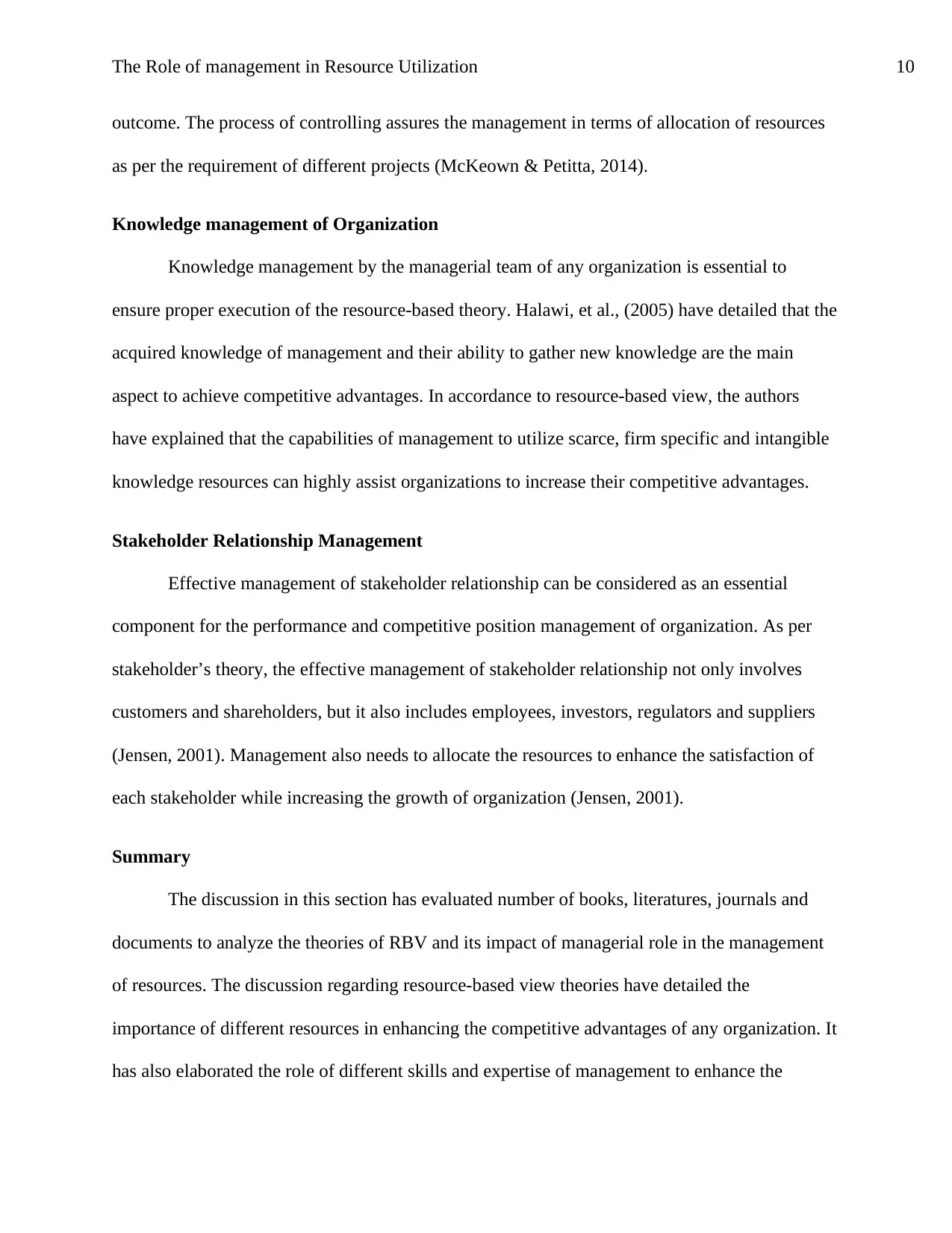
The Role of management in Resource Utilization 10
outcome. The process of controlling assures the management in terms of allocation of resources
as per the requirement of different projects (McKeown & Petitta, 2014).
Knowledge management of Organization
Knowledge management by the managerial team of any organization is essential to
ensure proper execution of the resource-based theory. Halawi, et al., (2005) have detailed that the
acquired knowledge of management and their ability to gather new knowledge are the main
aspect to achieve competitive advantages. In accordance to resource-based view, the authors
have explained that the capabilities of management to utilize scarce, firm specific and intangible
knowledge resources can highly assist organizations to increase their competitive advantages.
Stakeholder Relationship Management
Effective management of stakeholder relationship can be considered as an essential
component for the performance and competitive position management of organization. As per
stakeholder’s theory, the effective management of stakeholder relationship not only involves
customers and shareholders, but it also includes employees, investors, regulators and suppliers
(Jensen, 2001). Management also needs to allocate the resources to enhance the satisfaction of
each stakeholder while increasing the growth of organization (Jensen, 2001).
Summary
The discussion in this section has evaluated number of books, literatures, journals and
documents to analyze the theories of RBV and its impact of managerial role in the management
of resources. The discussion regarding resource-based view theories have detailed the
importance of different resources in enhancing the competitive advantages of any organization. It
has also elaborated the role of different skills and expertise of management to enhance the
outcome. The process of controlling assures the management in terms of allocation of resources
as per the requirement of different projects (McKeown & Petitta, 2014).
Knowledge management of Organization
Knowledge management by the managerial team of any organization is essential to
ensure proper execution of the resource-based theory. Halawi, et al., (2005) have detailed that the
acquired knowledge of management and their ability to gather new knowledge are the main
aspect to achieve competitive advantages. In accordance to resource-based view, the authors
have explained that the capabilities of management to utilize scarce, firm specific and intangible
knowledge resources can highly assist organizations to increase their competitive advantages.
Stakeholder Relationship Management
Effective management of stakeholder relationship can be considered as an essential
component for the performance and competitive position management of organization. As per
stakeholder’s theory, the effective management of stakeholder relationship not only involves
customers and shareholders, but it also includes employees, investors, regulators and suppliers
(Jensen, 2001). Management also needs to allocate the resources to enhance the satisfaction of
each stakeholder while increasing the growth of organization (Jensen, 2001).
Summary
The discussion in this section has evaluated number of books, literatures, journals and
documents to analyze the theories of RBV and its impact of managerial role in the management
of resources. The discussion regarding resource-based view theories have detailed the
importance of different resources in enhancing the competitive advantages of any organization. It
has also elaborated the role of different skills and expertise of management to enhance the
Paraphrase This Document
Need a fresh take? Get an instant paraphrase of this document with our AI Paraphraser
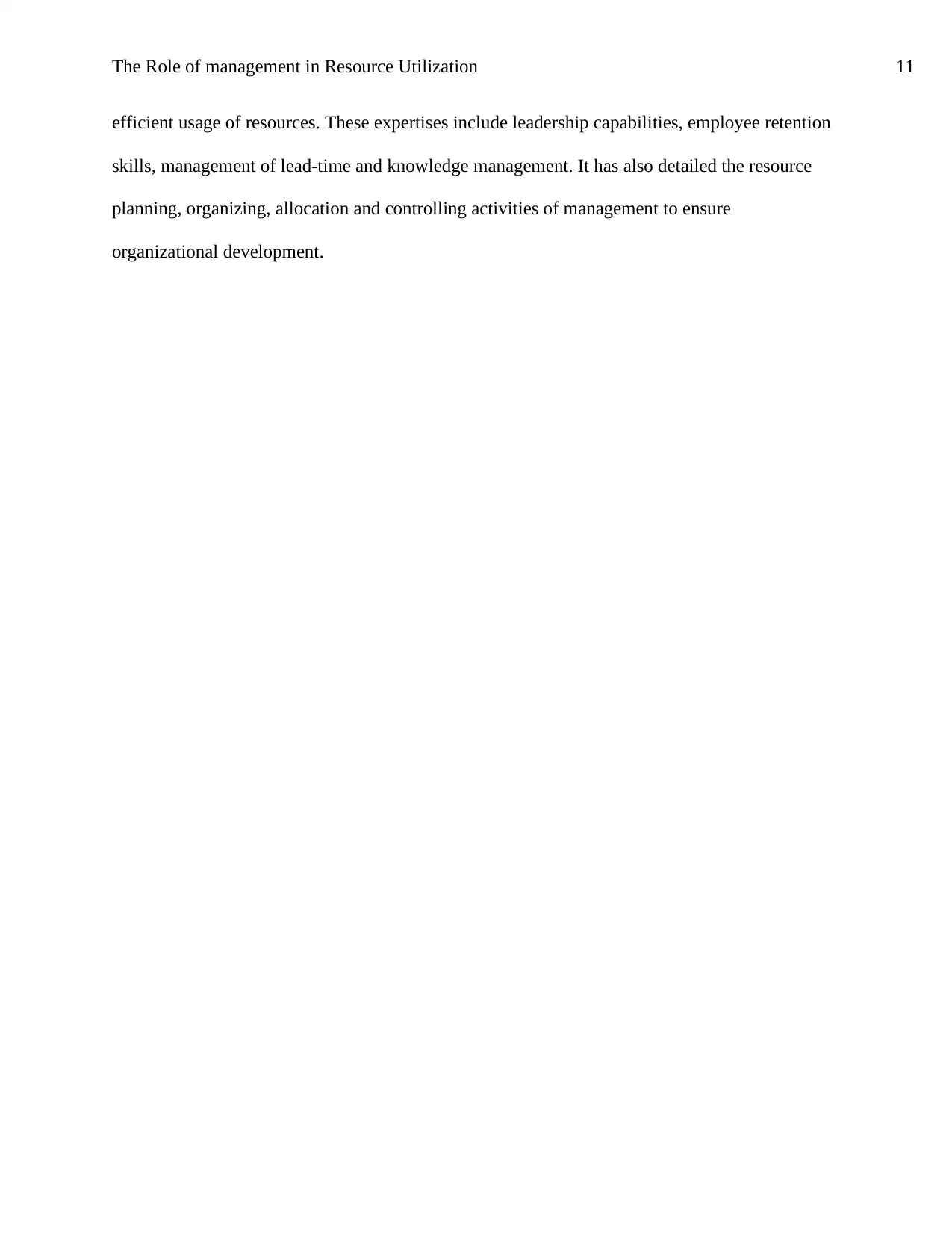
The Role of management in Resource Utilization 11
efficient usage of resources. These expertises include leadership capabilities, employee retention
skills, management of lead-time and knowledge management. It has also detailed the resource
planning, organizing, allocation and controlling activities of management to ensure
organizational development.
efficient usage of resources. These expertises include leadership capabilities, employee retention
skills, management of lead-time and knowledge management. It has also detailed the resource
planning, organizing, allocation and controlling activities of management to ensure
organizational development.
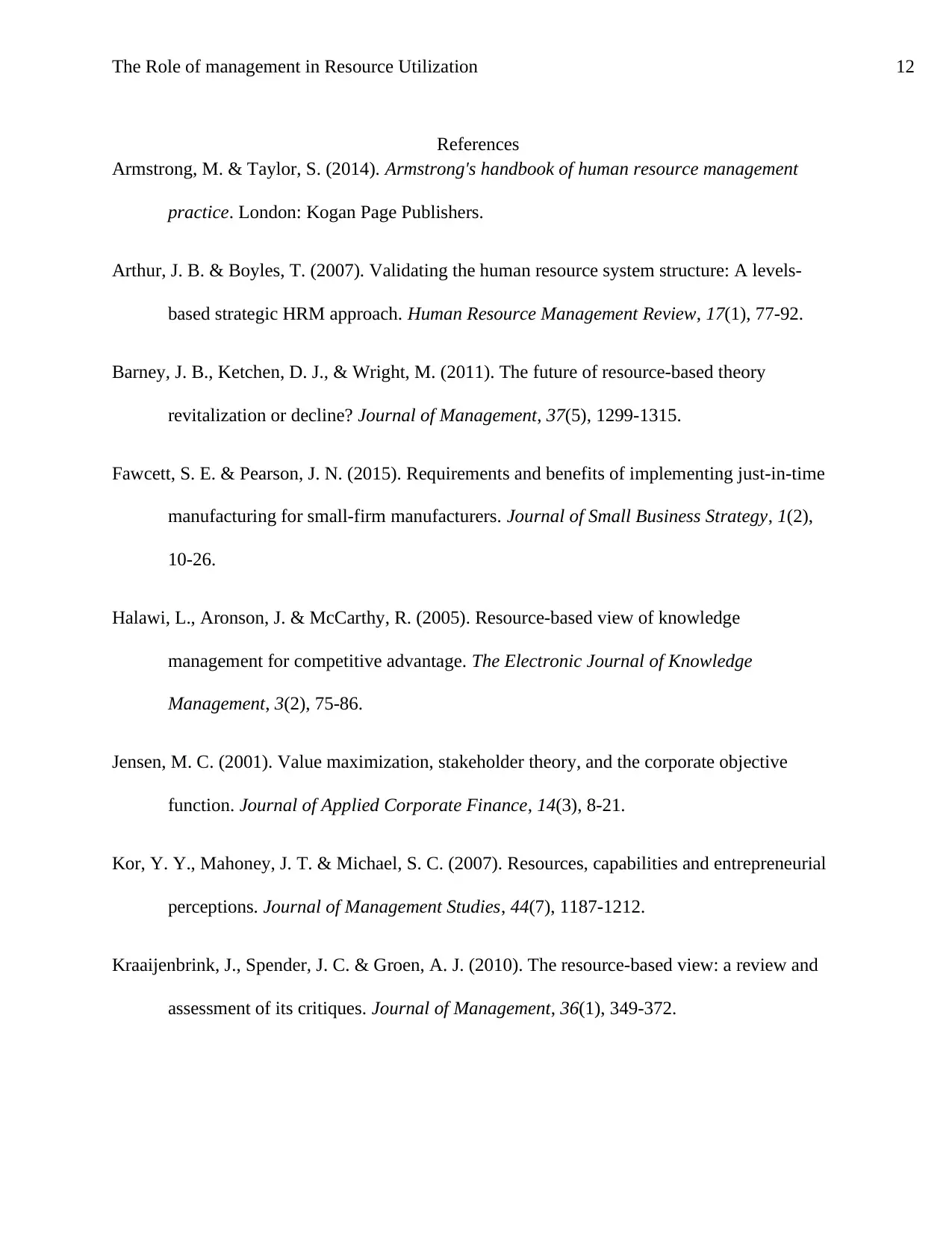
The Role of management in Resource Utilization 12
References
Armstrong, M. & Taylor, S. (2014). Armstrong's handbook of human resource management
practice. London: Kogan Page Publishers.
Arthur, J. B. & Boyles, T. (2007). Validating the human resource system structure: A levels-
based strategic HRM approach. Human Resource Management Review, 17(1), 77-92.
Barney, J. B., Ketchen, D. J., & Wright, M. (2011). The future of resource-based theory
revitalization or decline? Journal of Management, 37(5), 1299-1315.
Fawcett, S. E. & Pearson, J. N. (2015). Requirements and benefits of implementing just-in-time
manufacturing for small-firm manufacturers. Journal of Small Business Strategy, 1(2),
10-26.
Halawi, L., Aronson, J. & McCarthy, R. (2005). Resource-based view of knowledge
management for competitive advantage. The Electronic Journal of Knowledge
Management, 3(2), 75-86.
Jensen, M. C. (2001). Value maximization, stakeholder theory, and the corporate objective
function. Journal of Applied Corporate Finance, 14(3), 8-21.
Kor, Y. Y., Mahoney, J. T. & Michael, S. C. (2007). Resources, capabilities and entrepreneurial
perceptions. Journal of Management Studies, 44(7), 1187-1212.
Kraaijenbrink, J., Spender, J. C. & Groen, A. J. (2010). The resource-based view: a review and
assessment of its critiques. Journal of Management, 36(1), 349-372.
References
Armstrong, M. & Taylor, S. (2014). Armstrong's handbook of human resource management
practice. London: Kogan Page Publishers.
Arthur, J. B. & Boyles, T. (2007). Validating the human resource system structure: A levels-
based strategic HRM approach. Human Resource Management Review, 17(1), 77-92.
Barney, J. B., Ketchen, D. J., & Wright, M. (2011). The future of resource-based theory
revitalization or decline? Journal of Management, 37(5), 1299-1315.
Fawcett, S. E. & Pearson, J. N. (2015). Requirements and benefits of implementing just-in-time
manufacturing for small-firm manufacturers. Journal of Small Business Strategy, 1(2),
10-26.
Halawi, L., Aronson, J. & McCarthy, R. (2005). Resource-based view of knowledge
management for competitive advantage. The Electronic Journal of Knowledge
Management, 3(2), 75-86.
Jensen, M. C. (2001). Value maximization, stakeholder theory, and the corporate objective
function. Journal of Applied Corporate Finance, 14(3), 8-21.
Kor, Y. Y., Mahoney, J. T. & Michael, S. C. (2007). Resources, capabilities and entrepreneurial
perceptions. Journal of Management Studies, 44(7), 1187-1212.
Kraaijenbrink, J., Spender, J. C. & Groen, A. J. (2010). The resource-based view: a review and
assessment of its critiques. Journal of Management, 36(1), 349-372.
⊘ This is a preview!⊘
Do you want full access?
Subscribe today to unlock all pages.

Trusted by 1+ million students worldwide
1 out of 14
Related Documents
Your All-in-One AI-Powered Toolkit for Academic Success.
+13062052269
info@desklib.com
Available 24*7 on WhatsApp / Email
![[object Object]](/_next/static/media/star-bottom.7253800d.svg)
Unlock your academic potential
Copyright © 2020–2025 A2Z Services. All Rights Reserved. Developed and managed by ZUCOL.





